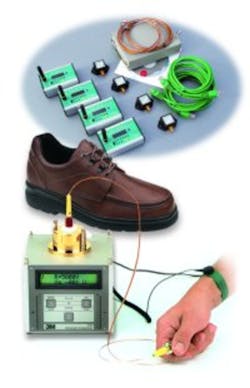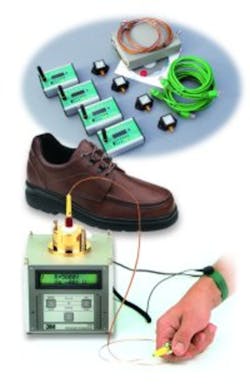“The most important new driving force in the ESD-control field is the ANSI/ESD S20.20 Standard,” said Dave Swenson, technical service specialist at the 3M Electronic Handling & Protection Division. “For the first time in history, all facets of the electronics community—commercial, military, OEMs, contract manufacturers, customers, suppliers—can work from the same set of principles. The result is a static-control program that is uniform, and the cost of implementation is much lower.”
Companies aren’t implementing the S20.20 ESD control program a day too soon. The technical challenge is growing by leaps and bounds as new chip and magnetic disk technologies become more complex.
“Several chip manufacturers are excited about a new technology—extreme ultraviolet lithography—that can etch circuits about 1/200 the width of a human hair,” observed Ingrid Cohen, vice president of marketing at Static Solutions. “This shows promise of producing memory chips with 1,000 times the capacity of today’s devices and microprocessors 100 times as powerful as those in use today. These new circuits, expected in less than a year, can be disabled by static discharges as low as 50 V.”
The Economic Driving Force
Most progressive electronics manufacturers see the ESD threat in terms of dollars. Totally ignoring the probable damage to their products and company reputations would cost a very large amount, and doing only half the job of fighting static discharge could be terribly risky. Sure, an ESD program isn’t cheap, but it’s far less expensive than the alternatives.
Even so, the urgency of the ESD threat isn’t fully understood and appreciated by only a few manufacturers. “They seek a low-cost ESD solution that is barely suitable when it is implemented,” said Mark Reiland, the sales/marketing manager at Eagle Manufacturing. “However, short-term marginally satisfactory solutions eventually require costly upgrades when workbench tops, mats, and other items must be replaced. Losses of products, production time, and the initial investment are the prices they pay for the small amount of money they saved up front.”
Facility Certification—A Dream or a Probability?
The ESD Association certifies individual ESD practitioners and is in the process of establishing a facility certification program for 20.20. According to Mr. Swenson of 3M, “As more and more ISO registrar companies become trained, we will see a dramatic increase in the demand for certification. By the end of this year, we expect at least three major contract manufacturers will have all their facilities certified, as will at least four major OEMs.”
Selecting Equipment for the Work Area
Each category of equipment for the workstation area has been developed with the user in mind. Since operator comfort and static prevention are important, they must be given equal status in ESD-control product design.
In workstation seating, for example, the selection will be strongly influenced by the type of facility, what products are being manufactured, and the types of devices used in those products. “The ESD-protective chair is built so every part is grounded to the base,” said Jim Frobose, director of engineering at BioFit. “There must be continuity from the top of the backrest through the seat, adjustment mechanism, base, drag chain, and conductive gliders or casters. It also should be used on a conductive floor or mat.
“This is just the beginning,” he continued. “The ESD protection characteristics must be monitored to ensure continued static control.”
In another facet of ESD control, static-protective barrier bag specifications are being reevaluated. “More manufacturers need moisture protection for sensitive components,” noted Brent Beamer, technical director at Static Control Components, “and IPC/JEDEC STD-033 responded to this by moving the moisture vapor transmission rate (MVTR) from 0.02 g/100 in.2/24 h to 0.002 g/100 in.2/24 h. This forces the use of foil barriers, new indicator cards, and additional desiccant.
“The use of metal-out static-shielding bags and moisture-barrier bags is increasing in the disk manufacturing sector since these packages retain less charge than metal-in bags. Sensitive components are less likely to be damaged as they are removed from these bags,” he explained.
Other parts of the ESD protection picture have been developed with this same attention to detail. As a result, the product showcase describes a wide range of instruments to monitor performance as well as equipment to control this invisible threat.
Return to EE Home Page
Published by EE-Evaluation Engineering
All contents © 2001 Nelson Publishing Inc.
No reprint, distribution, or reuse in any medium is permitted
without the express written consent of the publisher.
May 2001

